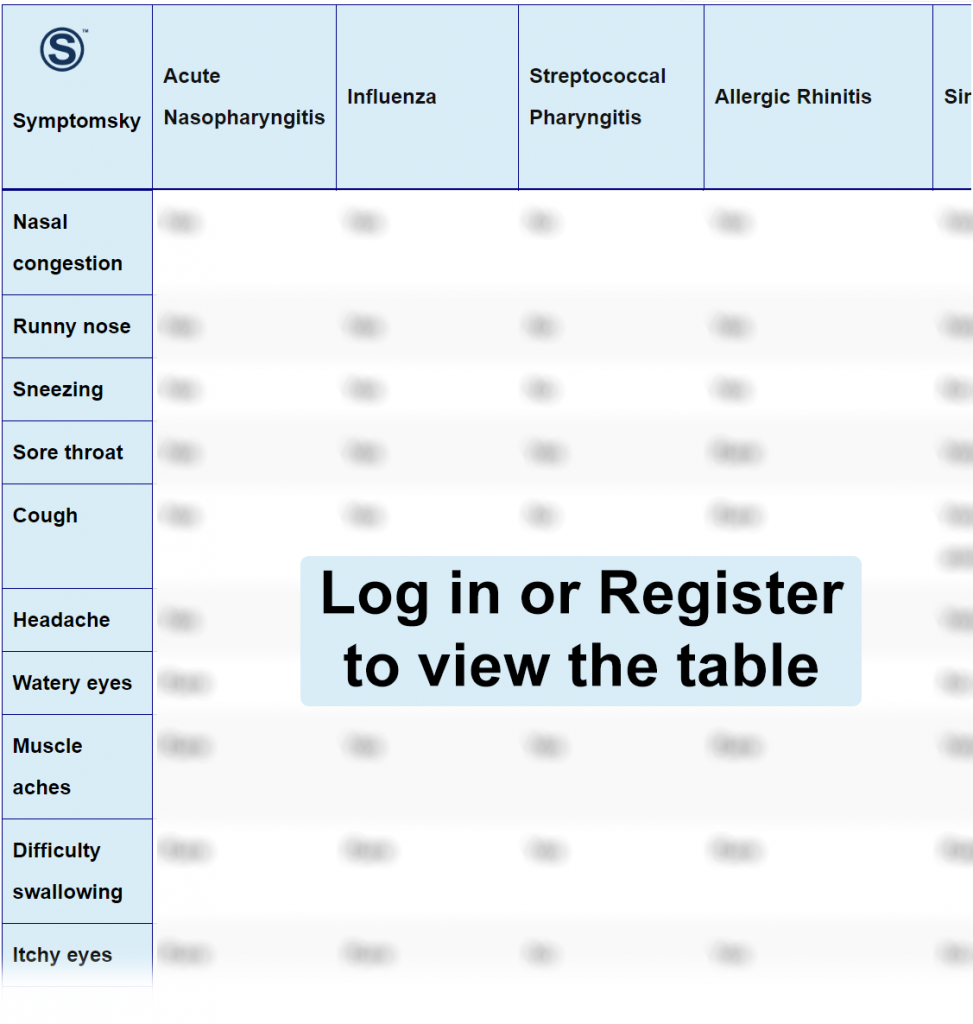Contents
- 1 Acute Nasopharyngitis Differential Diagnosis Table:
- 2 How to Distinguish Acute Nasopharyngitis from Other Diseases
- 2.1 Distinguish Acute Nasopharyngitis from Influenza – Diagnosis
- 2.2 Distinguish Acute Nasopharyngitis from Streptococcal Pharyngitis – Diagnosis
- 2.3 Distinguish Acute Nasopharyngitis from Allergic Rhinitis – Diagnosis
- 2.4 Distinguish Acute Nasopharyngitis from Sinusitis – Diagnosis
- 2.5 Distinguish Acute Nasopharyngitis from Bronchitis – Diagnosis
- 2.6 Distinguish Acute Nasopharyngitis from Pneumonia – Diagnosis
- 2.7 Distinguish Acute Nasopharyngitis from COVID-19 – Diagnosis
- 2.8 Distinguish Acute Nasopharyngitis from Mononucleosis – Diagnosis
- 2.9 Distinguish Acute nasopharyngitis from Adenoiditis – Diagnosis
- 3 Acute Nasopharyngitis Complications and Treatment
Acute Nasopharyngitis Differential Diagnosis Table:

Acute nasopharyngitis, also known as “Common cold,” is an inflammation in the upper respiratory tract, including the pharynx and nasal passages.
Acute nasopharyngitis is experienced as sneezing, coughing, rhinorrhea, sore throat, general malaise, and low-grade fever (may be present). It can be diagnosed clinically, in addition to nasopharyngeal swab ELISA or PCR and rapid strep test.
The common cold is the most common human illness that causes absenteeism from school or work, due to feeling unwell. The common cold is transmitted through droplets (during coughing or sneezing), in addition to the survival rate of the virus on surfaces for hours. This shows the importance of good hygiene practices and avoiding close contact.
How to Distinguish Acute Nasopharyngitis from Other Diseases
Distinguish Acute Nasopharyngitis from Influenza – Diagnosis
- Influenza includes upper and lower respiratory passages, while acute nasopharyngitis includes upper respiratory passages only.
- Influenza is associated with high-grade fever, while in acute nasopharyngitis low-grade fever may be present.
- Influenza is accompanied by frontal headache, eye congestion, and muscle aches, yet acute nasopharyngitis is not accompanied by any of these symptoms.
“Laboratory tests such as rapid antigen test and viral culture or PCR of throat swab are used for differential diagnosis.”
Distinguish Acute Nasopharyngitis from Streptococcal Pharyngitis – Diagnosis
- Streptococcal pharyngitis only affects the pharynx, while acute nasopharyngitis affects nasal passages and pharynx.
- Streptococcal pharyngitis is experienced as a sudden onset of fever with the absence of rhinorrhea and coughing, while acute nasopharyngitis is experienced as rhinorrhea, coughing, and low-grade fever may be present.
- Streptococcal pharyngitis is exhibited physically as lymphadenopathy, tonsillar exudate, and pharyngeal inflammation, while all those signs are absent in acute nasopharyngitis.
“Throat culture for Streptococcal group A and Rapid antigen detection test are used for differentiation.”
Distinguish Acute Nasopharyngitis from Allergic Rhinitis – Diagnosis
- Allergic rhinitis has a seasonal pattern, while acute nasopharyngitis can be present anytime during the year.
- Allergic rhinitis is associated with a distinctive appearance of mouth breathing, watery eyes, dark circles under eyes, and nasal crease, while all of these signs are absent in acute nasopharyngitis.
- Allergic rhinitis is not accompanied by sore throat or fever, unlike in acute nasopharyngitis where sore throat is a crucial symptom and low-grade fever may be present.
“Detailed history and allergen-specific IgE serum testing are used for differentiation.”
Distinguish Acute Nasopharyngitis from Sinusitis – Diagnosis
- Sinusitis is associated with facial pressure/pain, decreased sense of smell, nasal obstruction, and nasal purulence, yet all of these signs and symptoms are absent in acute nasopharyngitis.
- Sinusitis appears clinically as facial swelling, cervical adenopathy, periorbital edema, and postnasal drainage, yet all of these signs are absent in acute nasopharyngitis.
“CT scan, nasal endoscopy, and nasal culture are used for differentiation.”
Distinguish Acute Nasopharyngitis from Bronchitis – Diagnosis
- Bronchitis involves the lower respiratory tract (inflammation of bronchi), while acute nasopharyngitis involves the upper respiratory tract.
- Bronchitis is not associated with sneezing, coughing, rhinorrhea, and sore throat, while these symptoms are crucial in acute nasopharyngitis.
- Bronchitis has an acute onset of persistent cough, difficulty in breathing, and wheezing, while acute nasopharyngitis has a normal coughing pattern without difficulty in breathing nor wheezing.
“Lung auscultation (wheezing), PCR, chest X-ray, Pulmonary function test, Blood-oxygen saturation, and CBC are used for differentiation.”
Distinguish Acute Nasopharyngitis from Pneumonia – Diagnosis
- Pneumonia is associated with pleuritic chest pain and productive cough, which are all absent in acute nasopharyngitis.
- Sore throat, rhinorrhea, and nasal congestion are absent in pneumonia, while they are crucial symptoms in acute nasopharyngitis.
“CT (lung abscess), chest X-ray, and Blood tests are used for differentiation.”
Distinguish Acute Nasopharyngitis from COVID-19 – Diagnosis
- COVID-19 is not associated with nasal manifestations (nasal congestion & rhinorrhea), while nasal manifestations are crucial symptoms in acute nasopharyngitis.
- COVID-19 is accompanied by shortness of breath, headache, loss of taste and smell, and gastrointestinal manifestations (diarrhea and vomiting), while all absent in acute nasopharyngitis.
“RT-PCR and CT scan are used for differentiation.”
Distinguish Acute Nasopharyngitis from Mononucleosis – Diagnosis
- Mononucleosis is not associated with nasal manifestations (nasal congestion & rhinorrhea), while nasal manifestations are crucial symptoms in acute nasopharyngitis.
- Mononucleosis is accompanied by lymphadenopathy and difficulty in swallowing, which are both absent in acute nasopharyngitis.
- Fever is a crucial symptom in mononucleosis, while it may be present as low-grade fever in acute nasopharyngitis.
“Heterophile antibody test is the gold standard for differentiation, in addition to laboratory tests and airway assessment.”
Distinguish Acute nasopharyngitis from Adenoiditis – Diagnosis
- Adenoiditis is associated with swollen adenoids, bad breath, post-nasal drip, and acute otitis media, yet all signs are absent in acute nasopharyngitis.
“Rapid strep test, throat culture, nasal endoscopy, and CT-scan are used for differentiation.”
Acute Nasopharyngitis Complications and Treatment
Acute nasopharyngitis is a self-limiting and benign condition, yet in some cases (especially in immunocompromised patients and children under two) symptoms may exacerbate leading to rhinosinusitis, conjunctivitis, asthma exacerbations, acute otitis media, and pneumonia.
Supportive care is crucial for acute nasopharyngitis treatment such as rest, fluids, and symptomatic treatment. Pain medications (acetaminophen and ibuprofen) are used in addition to antitussives, decongestants, and expectorants.
